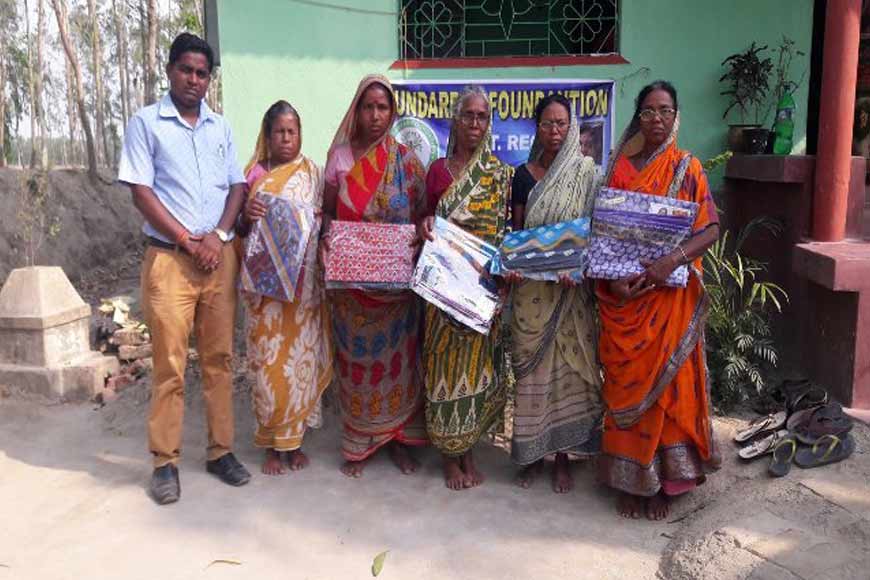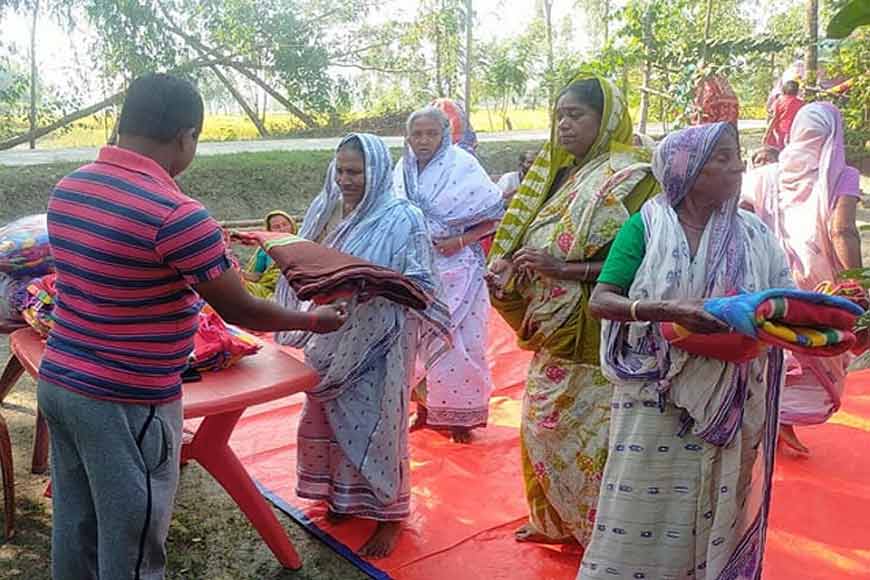Charting a safe income for Tiger Widows of Sundarbans

Wildlife enthusiasts from across the globe dream of catching just a glimpse of the majestic predator of the world's largest mangrove forest. But for the people living with the swamp tigers of the Sundarbans, such an encounter converts to a death sentence for them. Even in the 21st century, many villagers living in the numerous islands of the Sundarbans ecoregion become tiger prey as they tread into tiger territory, lured by the riches the mangrove forests have to offer. But for these people, this is just a way of life. They also acknowledge that the forest is the kingdom of the tiger so when humans intrude into its territory, it is normal that the predator attacks.
Sundarbans, a dense mangrove forest ecoregion at the Ganga-Brahmaputra River delta of India and Bangladesh, is truly a place where the primal fears of humanity come alive. Here humans are a part of the food chain and often serve as prey to the mighty Sundarbans tiger. Numerous islands remain scattered in this delta region covered by thick mangrove forests with trees adapted to survive the saltwater environment. While humans have exerted their supremacy in some of the islands, others remain under tiger dominance. In this unforgiving landscape where waves and winds constantly batter the coast to make life difficult for every inhabitant, a unique relationship has developed between the people and the tigers.

Tigers in the Sundarbans find hunting difficult. They have to cautiously tread through the thick slush dotted with jagged aerial roots of the mangrove trees in search of prey. They have to swim long distances in crocodile and shark-infested waters against strong currents searching for food, mate, and territory. Under such circumstances, an accidental meeting with humans obviously mean bad news for the latter.
However, such encounters are frequent due to people’s heavy dependence on the forest. The Sundarbans is famous for its crabs, fish, and honey that have high market value. With much of the forest area protected, the law allows the villagers to visit only permitted spaces for extracting honey, harvesting crab, and other fishing. But poverty and greed render such laws ineffective, as many still enter the prohibited forest areas for a better catch.
While the forest department sells permits every year to people looking to earn a living from the forest, the permits are expensive and are further restricted to certain zones. The result is a tiger refuge that is highly protected, but also very rich and attractive to those willing to break the rules. Incidents involving illegal forest entries don't get recorded, and wildlife attack victims and their families are ineligible for compensation if they haven't adhered to the rules.

About 5,000 people frequent the swamps and waterways of the Sundarbans. Fishing boats traverse the area and many stop to collect firewood, honey and other items. In the dark forest, tigers find it easy to stalk and attack men absorbed in their work. Even fishermen in small boats have been attacked due to tigers' strong swimming abilities.
Over the years, the forest department and NGOs working in the Sundarbans have tried to provide alternative income sources to the villagers to discourage them from going to the forest. Alternative sources of livelihood do exist, but the profit gained from selling crabs, fish, and honey from the forest is much higher and comes quicker than other ways of living. For them, earning from the forest is easier even if the fear of death is always there.
About 5,000 people frequent the swamps and waterways of the Sundarbans where fish and crabs are plentiful. Fishing boats traverse the area and many stop to collect firewood, honey and other items. In the dark forest, tigers find it easy to stalk and attack men absorbed in their work. There are around 3,000 tiger widows in the islands of the Sundarbans, women whose husbands have been killed by tigers while they were fishing, catching crabs or collecting honey for their livelihood. Always challenged by natural disasters and human-animal conflicts, the people of these villages don’t have permits from the forest department to go to the core area, which makes their work illegal. The bagh-bidhobas or tiger widows, therefore, cannot claim compensation and so they rarely inform the authorities about tiger-linked deaths. Almost every villager in these islands has a tragic story to narrate.
Also read : New lease of life for Sunderbans’ tiger widows
The state government as well as NGOs have introduced the villagers to poultry farming and aquaculture practices so that they can meet their domestic needs and sell the surplus in the market. They have been encouraged to set up vegetable gardens outside their homes to grow their own food. With the help of Indian Council of Agricultural Research (ICAR) and other organizations, villagers are trained to multiple crop farming using scientific methods. Tourism is also gaining ground as major source of income for the locals here. Recently the Gosaba-based Sundarbans Tiger Widow Welfare Society, working for the welfare of the bagh-bidhobas or tiger widows and also victims of crocodile and shark bites, helped the widows launch a project that will help them earn a living in a sustainable way.
The ‘fearful symmetry’ of the predators have cast a spell on all onlookers since time immemorial and tourists vie to watch the apex predator in its natural habitat. This has inspired the ‘bagh-bidhobas’ to recreate terracotta models of tigers and crocodiles and sell them to tourists as memorabilia. The idea was conceptualized by marine social scientist, Raj Sekhar Aich, a professor at Sister Nivedita University. A few months ago, he connected with the Sundarbans Tiger Widow Welfare Society and suggested the scheme to launch a self-sustainable economic model for the poor, hapless widows and the idea struck as viable too.
When the volunteers of the society mooted the concept to the tiger widows, the women agreed and joined in the project eagerly. After a substantial volume of terracotta miniatures of tigers and crocodiles were ready, the society helped them rent a stall at Pakhiralay market, a popular tourist destination in the Gosaba sub-division of South 24 Parganas. On September 4, the shop was launched formally to display and sell their works.

Sundarban Foundation is another prominent NGO that works for upliftment of the community in Sundarban at large, and the vulnerable tiger-victim groups in particular. The organization offers multi-faceted community development and healthcare support. The foundation provides education, market-oriented vocational training, rural health care, formation of cooperatives of marginal and sub-marginal peasants and sharecroppers and alternative opportunities to tiger survivors. Women are trained in tailoring, knitting, making decorative and utility items from cane, bamboo etc. The children of the tiger widows are helped to pursue education. Prasenjit Mondal, chairman of the Sundarban Foundation, and a son of the soil says the pressure to survive is tremendous for any family in the Sundarbans. But it is several notches higher for tiger widows who also battle post-traumatic stress. These women are the sole breadwinners of their families, usually taking care of three to four children and sometimes also elderly members of the family.

The tiger widows have been facing starvation after their spouses were mauled to death. However, since 2018, around 500 tiger widows have been receiving training under Mondal’s supervision for beekeeping, making handspun and hand-woven khadi cloth, making leather pouches, money bags and belts in Bali Islands. Crabbing and fishing in the Sundarbans are one of the most dangerous occupations in the world. Many of the tiger widows have children in the age group of 9-14, who are unable to continue their education after their father’s death and end up doing the same perilous jobs as their parents, rues Mondal. However, with committed NGOs working tirelessly to rehabilitate the worst affected among the people, including the tiger widows, The scenario looks pretty optimistic and the day is not too far when the tiger widows will be the instrument of change and herald in a new dawn where man and beast will learn to co-exist harmoniously in the wild, wild, swamps of Sundarbans.











